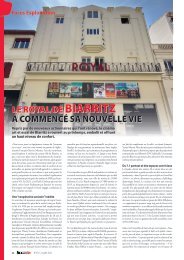Boxoffice-January.07.1950
Create successful ePaper yourself
Turn your PDF publications into a flip-book with our unique Google optimized e-Paper software.
This auditorium yiew of the Lake Theatre<br />
illustrates clearly the structural economy<br />
possible with close cooperation of<br />
decorator and architect. The turquoise<br />
satin wall drapes which extend onethird<br />
of the way back into the auditorium<br />
form a decorative wall over the<br />
outside masonry wall. Exits are made<br />
by curtain draping.<br />
Heights, a fast-growing new suburb of Cleveland where building<br />
of both residential and commercial units is mushrooming. At<br />
the outset this theatre project was put into the hands of architects<br />
Matzinger and Grosel, of Cleveland, and Rex M. Davis, of<br />
our studios, was called in to coordinate interiors with the architectural<br />
theme as it progressed. This advance planning was called<br />
for by Howard Reif who heads the Mayland Theatre Co.. composed<br />
of P. E. Essick and J. J. Jossey. Reif took an active personal<br />
interest in the new theatre from the drafting board stage<br />
to opening night, which came off exactly on the date scheduled.<br />
Our second example, the Lake Theatre, is located in a similarly<br />
fast-growing suburb east of Cleveland, and was handled in the<br />
same manner by Matzinger and Grosel and Rex M. Davis. Also<br />
an inspiration of Reif's, the Lake is controlled through the Lake<br />
Shore Theatre Co. which includes M. S. Pine. A. Kramer, James<br />
Kalafat, S. Stecher and James Templeton.<br />
As to economy, let's see if you don't agree that a beautiful<br />
interior was achieved in both of these theatres, even though some<br />
of the constructional details were revolutionary. Rather than the<br />
usual ornate and expensive type of architectural proscenium<br />
treatment, both of these houses employ rich drapery hung in a<br />
curve free of the outside walls in such a way as to form a decorative<br />
inner wall by itself. The curtain is simply caught back in<br />
graceful folds to form an opening at the exits. This material,<br />
fireproofed of course, not only creates a most luxurious effect, but<br />
contributes to the fine acoustics of a theatre while providing an<br />
architectural short-cut to beauty that represents a tremendous<br />
savings over the conventional handling. Still another impressive<br />
saving was registered in the auditoriums by the application of<br />
acoustical blocks directly to the outside masoni-y walls. This surface,<br />
in turn, was decorated with hand executed murals.<br />
The illustrations of these theatres certainly give no impression<br />
that they are economy houses. For example, the lobby of the<br />
'4*<br />
This refreshment stand in the Mayland Theatre is cleverly accented by the<br />
use of artistic display lighting. A portion of the domed ceiling is visible<br />
here, showing one of the four seasons of the year gracefully done in mural<br />
treatment and indirectly lighted from coves.<br />
Below is the mural adorning one sidewall of the Mayland Theatre. Done in<br />
fluorescent paint, this decorative wall presents one appearance under ordinary<br />
light, and an entirely different aspect of the same scene under black light.<br />
BOXOFFICE January 7, 1950

















